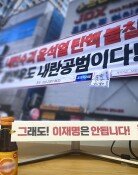‘With Corona’ ends in catastrophe after 45 days
‘With Corona’ ends in catastrophe after 45 days
Posted December. 16, 2021 07:43,
Updated December. 16, 2021 07:43
As of 12 a.m.Wednesday, the number of new daily COVID-19 patients and critical patients reached 7,828 and 964, which are the highest figures to date. “The current disease control situation will be taken more seriously and stronger social distancing guidelines will be implemented,” said South Korean Prime Minister Kim Boo-kyum on Wednesday. It has been 45 days since the gradual recovery of normal daily lives, which is also called the ‘With Corona’ system, was introduced on November 1. The government will announce guidelines as early as Thursday to reduce the number of people allowed in private gatherings to four people and restrict business hours of restaurants and cafes to 9 p.m.
Under the ‘With Corona’ system that allows an increase in new patients to some extent, the medical response system to take care of patients in a timely manner is critical. The government had been confident about having up to 10,000 new daily patients. However, by the 13th day of the ‘With Corona’ system, sickbeds for critical patients in Seoul were filled to near 75 percent, which is the threshold to implement emergency plans, despite the number of new daily patients being around 2,000. When the figure rose to 4,000 two weeks later, the occupation rates of sickbeds across the country exceeded 75 percent. It was because there were a number of patients with serious symptoms among seniors whose immune effects had weakened due to delayed booster shots. As the medical system has become paralyzed, the daily COVID-19 fatality rate of South Korea is 1.62 as of Tuesday. The figure is five times higher than the U.K. whose fatality rate is 0.28 despite the fact that about 50,000 new patients are diagnosed daily in the country.
The special disease control measures put forward by the government on November 29 and December 3 hadn’t had much effect due to the lack of preparation. While home care has been mandated, many patients under home care passed away due to the poor management of home care patients and the lack of an emergency response system. The vaccine pass, which was introduced on Monday after a week of guidance period, stopped functioning due to server overload. The government failed to avoid access errors, which also occurred for vaccine reservations from June through August, even after the guidance period.
Now, patients have to wait dozens of hours for an ambulance, even when a bed is available. Even before Omicron, the highly infective variant, spreads in the country, the number of new daily patients is expected to reach 9,500 by the end of this month and 15,000 by the end of next month. The government should prevent any further catastrophe by implementing social distancing guidelines and present support measures for small business owners who will take the biggest hit. The government has been worsening damage to both the disease control efforts and the economy by breaking its own rules and postponing the implementation of emergency plans even after the sickbed occupation rates and weekly risk ratings reached thresholds. It should not make the same mistake of losing both by revamping the emergency plan manual.
Headline News
- Pres. Yoon refuses impeachment documents for a week
- Debate over Lee’s participation causes friction in government consultative body
- Food and dining prices could increase en masse next year
- Foreign couple borrowed over $2 million to buy a Seoul house
- One-third of Japanese companies keep workers employed until 70







